Tacoma Narrows Bridge history - Art - Style for a new span
Style for a new span - Artistic trends and the 1950 bridge
Artistic trends of the 1940s leave their mark on Galloping Gertie's replacement.
What's here?
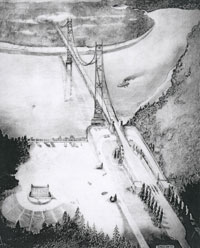
Artist's sketch of 1950 bridge WSA, WSDOT records
Artistic trends of the 1940s
The artistic spirit that formed the 1950 Narrows Bridge differed markedly from that of its predecessor. The state's design team felt keenly aware of Galloping Gertie's problems. That spectacular failure loomed large in their conscious efforts to design a new span. But, the 1950 Tacoma Narrows Bridge was far more than a simple reaction to the failure of its predecessor.
After 1945 the practical considerations and aesthetic trends that shape suspension bridges all changed. There were different program requirements and different personalities designing the 1950 bridge. Local circumstances had changed too.
A host of new currents in the artistic, social, economic, and political life of the country were part of the working environment for the designers of the 1950 Narrows Bridge. In the post-war years, America entered a time of unprecedented prosperity. The United States, now the dominant global military power, faced off with the Soviet Union in what soon became known as the "cold war." National security concerned the entire nation.
Artistic styles differed markedly from the pre-war era. The old debate between traditionalists and modernists that pervaded the 1920s and 1930s was settled. New, modern design approaches had helped democracy defeat fascism. Standardization and pre-fabricated parts played an increasingly important role in advancing construction methods. Rational and technologically sophisticated designs proliferated for bridges, buildings, and structures of all kinds.
Uncertainty was everywhere in the new atomic age. The drive for certainty affected all corners of society, including the one occupied by the designers of the Tacoma Narrows Bridge.

1950 Narrows Bridge, tower face sketch WSDOT
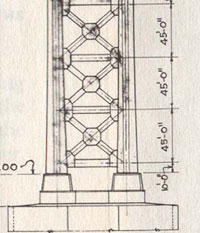
Tower detail, "X" cross-brace below deck drawing WSDOT
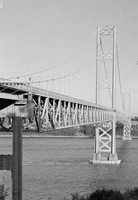
Beach level view, September 1950 WSDOT
Art of the Current Narrows Bridge
At the time of its completion in October 1950, the second (current)Tacoma Narrows Bridge was the most advanced of its day. Some engineers have criticized the design as "too cautious," and "ultra conservative." Principal consulting engineer Charles Andrew and design engineer Dexter Smith intentionally created a design that would have the least possible chance of repeating Galloping Gertie's performance.
Aesthetically, they produced an astonishing statement. They chose the structural form with greatest strength, the "X" cross-brace between tower legs. Structurally, the cross-bracing pattern resists forces that pull or twist the tower. The "X" also is the ultimate graphic expression that conveys strength, power, and solidity. Aesthetically, it became the dominant design element.
The bridge features 3 large panels of double-"X" cross-braces between the tower legs above the deck and 3 single "X" cross-braces below the deck. The huge "X" braces below deck measure roughly 60 feet wide and 45 feet high. The pattern of cross-bracing establishes a firm sense of balance and proportion that is enhanced by the straight, vertical line of the tower legs. The towers, connected by the 33-foot deep "W" of the Warren truss, achieved a technical and artistic strength of unprecedented magnitude.
The massive "X" was prominent in numerous preceding spans. The 1937 Golden Gate Bridge, which influenced design of the upper tower bracing on the 1940 Narrows Bridge, uses two prominent "X" braces below the roadway.
Other notable examples of suspension towers employing the "X" pattern are found in such celebrated spans as the George Washington Bridge (1931), the San Francisco-Oakland Bay Bridge (1936), and the Mackinac Strait Bridge (1957). In comparing the tower design of the 1950 Narrows Bridge with the 1936 San Francisco-Oakland Bay Bridge, it is worth remembering that Charles Andrew led the design and construction of both spans.
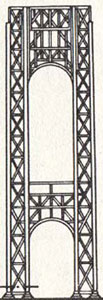
George Washington Bridge (1931) tower sketch WSDOT

Golden Gate Bridge (1937) tower sketch WSDOT
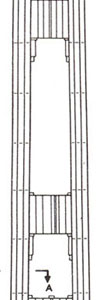
San Francisco-Oakland Bay Bridge (1936) tower sketch WSDOT
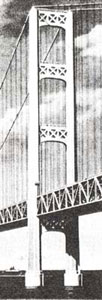
Mackinac Strait Bridge (1957) WSDOT
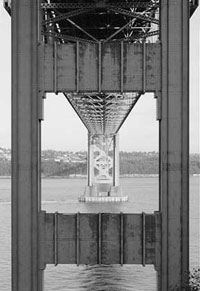
View under deck, showing 1940 part of 1950 bridge WSDOT
One fascinating feature of the current bridge is often overlooked. The west side span support, "Tower 3," was undamaged when the 1940 Bridge fell into the Narrows. It remained and became an integral part of the current Narrows Bridge.